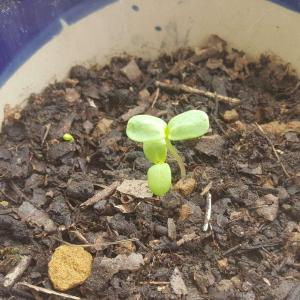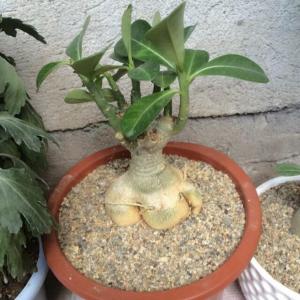文章
Colour_
2017年08月09日
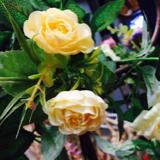

一旦出现叶片东倒西歪的现象,也不必惊慌,可通过以下方法解决:
(1)如果盆内还有空间,首先培土固定根部;
(2)经常转动花盆,利用植物趋光性调整叶片方向;
(3)通过阳光直射、适度低温、控制浇水等方法,延缓生长速度;
(4)适当修剪,降低茎叶高度,保证株型挺拔美观。
修剪要切记“适度”原则,建议每次不超过1厘米,可多次修剪。蓓蕾期修剪更要慎重,个别花友一剪子下去,花蕾也随之落下,十分可惜。修剪时剪口尽量保持一定斜度,使叶形更加自然。
0
0
文章
Dummer. ゛☀
2017年08月08日

Family - Apiaceae
Stems - To +/-1m tall, glabrous, often glaucous, erect, herbaceous, fistulose, fragrant, branching near the apex, from a taproot.
Leaves - Alternate, petiolate below, sessile above, 2-3 ternately compound, glabrous. Petioles expanded and sheathing at the base, to 13cm long. Leaflets entire, oblong to elliptic or oblanceolate, mucronate (commonly), +/-2.5cm long, +/-1cm broad, glaucous abaxially.
Inflorescence - Terminal and lateral compound umbels with +/-10 rays per umbel. Peduncles glabrous, to +/-10cm in fruit. Rays glabrous, -4cm long. Raylets 2-5mm long. No bracts subtending any of the rays.
Flowers - Petals 5, yellow, spreading or (more commonly) inflexed, apiculate, to 2mm long. Stamens 5, exserted, erect to spreading. Filaments pale yellow, glabrous, to 2.5mm long. Anthers pale yellow, .5-.6mm long. Styles 2, +2mm long, spreading and twisted, glabrous, whitish at the base, purplish near the apex. Stylopodium green, thick. Ovary inferior, slightly compressed, glabrous, 2-locular. One seed per locule. Flowers have a tendency to be either pistillate (with reduced to no stamens) or staminate (with reduced pistil).
Flowering - May - July.
Habitat - Rocky and dry open woods or upland woods, prairies, ledges along bluffs.
Origin - Native to U.S.
Other info. - This species can be found through Missouri but is most common in the Ozarks. The plant is easy to ID either in flower or vegetatively because of its big leaves, which have oblong and entire leaflets. In flower, of course, the yellow flowers are a good characteristic for ID as no other member of our flora has the plants distinct combination of yellow flowers and oblong leaflets.
Stems - To +/-1m tall, glabrous, often glaucous, erect, herbaceous, fistulose, fragrant, branching near the apex, from a taproot.
Leaves - Alternate, petiolate below, sessile above, 2-3 ternately compound, glabrous. Petioles expanded and sheathing at the base, to 13cm long. Leaflets entire, oblong to elliptic or oblanceolate, mucronate (commonly), +/-2.5cm long, +/-1cm broad, glaucous abaxially.

Inflorescence - Terminal and lateral compound umbels with +/-10 rays per umbel. Peduncles glabrous, to +/-10cm in fruit. Rays glabrous, -4cm long. Raylets 2-5mm long. No bracts subtending any of the rays.
Flowers - Petals 5, yellow, spreading or (more commonly) inflexed, apiculate, to 2mm long. Stamens 5, exserted, erect to spreading. Filaments pale yellow, glabrous, to 2.5mm long. Anthers pale yellow, .5-.6mm long. Styles 2, +2mm long, spreading and twisted, glabrous, whitish at the base, purplish near the apex. Stylopodium green, thick. Ovary inferior, slightly compressed, glabrous, 2-locular. One seed per locule. Flowers have a tendency to be either pistillate (with reduced to no stamens) or staminate (with reduced pistil).

Flowering - May - July.
Habitat - Rocky and dry open woods or upland woods, prairies, ledges along bluffs.
Origin - Native to U.S.
Other info. - This species can be found through Missouri but is most common in the Ozarks. The plant is easy to ID either in flower or vegetatively because of its big leaves, which have oblong and entire leaflets. In flower, of course, the yellow flowers are a good characteristic for ID as no other member of our flora has the plants distinct combination of yellow flowers and oblong leaflets.

0
0
文章
Colour_
2017年08月08日

#杜鹃花 的日常养护
关于浇水
杜鹃对土壤干湿度要求是润而不湿。一般春秋季节,对露地栽种的杜鹃可以隔2—3天浇一次透水,在炎热夏季,每天至少浇一次水。日常浇水,切忌用碱性水,浇水时还应注意水温不宜过冷,尤其在炎热夏天,用过冷水浇透,造成土温骤然降低,影响根系吸水,干扰植株生理平衡。
关于施肥
在每年的冬末春初,最好能对杜鹃园施一些有机肥料做基肥。4—5月份杜鹃开花后,由于植株在花期中消耗掉大量养分,随着叶芽萌发,新梢抽长,可每隔15天左右追一次肥。入伏后,枝梢大多已停止生长,此时正值高温季节,生理活动减弱,可以不再追肥。秋后,气候渐趋凉爽,且时有秋雨绵绵,温湿度宜于杜鹃生长,此时可做最后一次追肥,入冬后一般不宜施肥。
关于修枝
修剪整枝是日常维护管理工作中的一项重要措施,它能调节生长发育,从而使长势旺盛。日常修剪需剪掉少数病枝、纤弱老枝,结合树冠形态删除一些过密枝条,增加通风透光,有利于植株生长。对于杜鹃园须经常检查,发现有枯枝、病枝,应及时清除,以减少病虫害在杜鹃中蔓延。

关于浇水
杜鹃对土壤干湿度要求是润而不湿。一般春秋季节,对露地栽种的杜鹃可以隔2—3天浇一次透水,在炎热夏季,每天至少浇一次水。日常浇水,切忌用碱性水,浇水时还应注意水温不宜过冷,尤其在炎热夏天,用过冷水浇透,造成土温骤然降低,影响根系吸水,干扰植株生理平衡。
关于施肥
在每年的冬末春初,最好能对杜鹃园施一些有机肥料做基肥。4—5月份杜鹃开花后,由于植株在花期中消耗掉大量养分,随着叶芽萌发,新梢抽长,可每隔15天左右追一次肥。入伏后,枝梢大多已停止生长,此时正值高温季节,生理活动减弱,可以不再追肥。秋后,气候渐趋凉爽,且时有秋雨绵绵,温湿度宜于杜鹃生长,此时可做最后一次追肥,入冬后一般不宜施肥。
关于修枝
修剪整枝是日常维护管理工作中的一项重要措施,它能调节生长发育,从而使长势旺盛。日常修剪需剪掉少数病枝、纤弱老枝,结合树冠形态删除一些过密枝条,增加通风透光,有利于植株生长。对于杜鹃园须经常检查,发现有枯枝、病枝,应及时清除,以减少病虫害在杜鹃中蔓延。

1
2
文章
Colour_
2017年08月08日


养护#蝴蝶兰 并使其多开花是一项精细的工作。蝴蝶兰的新株要培养3年后才能形成花芽,开出艳丽的花朵。蝴蝶兰花芽的分化形成主要受温度的影响,既要求有一定的积温,又要有短时期的低温处理。
进入秋季后,晚间15~18℃的低温是保证其花芽分化的条件。此外对花苗进行每天18个小时的低温处理,连续处理一个半月后即可形成很多花芽。花芽形成后,夜间温度可以保持在18~20℃之间,经过3~4个月后即可开花了。
蝴蝶兰的花期较长,如果早期把花梗剪下作切花,则当年可第二次开花。蝴蝶兰随品种不同,开花的时间也不同,一般每一支花梗可长出十几朵花,由下到上逐次开放,一支花可开1个多月。
为促使其开花茂盛,可在生长季节向叶面和根部喷施些液体肥料。春天一般每3~4周施1次肥。开花时停止施肥,花后可每10天施1次肥。施肥以含磷、钾成分较高的液肥为主,要每次少施、淡施。夏季蝴蝶兰生长旺盛,可在盆面施1次固体有机肥,然后每周施1次液肥。秋季天凉后逐渐减少,到10月底可以停肥。
0
0
文章
Colour_
2017年08月08日

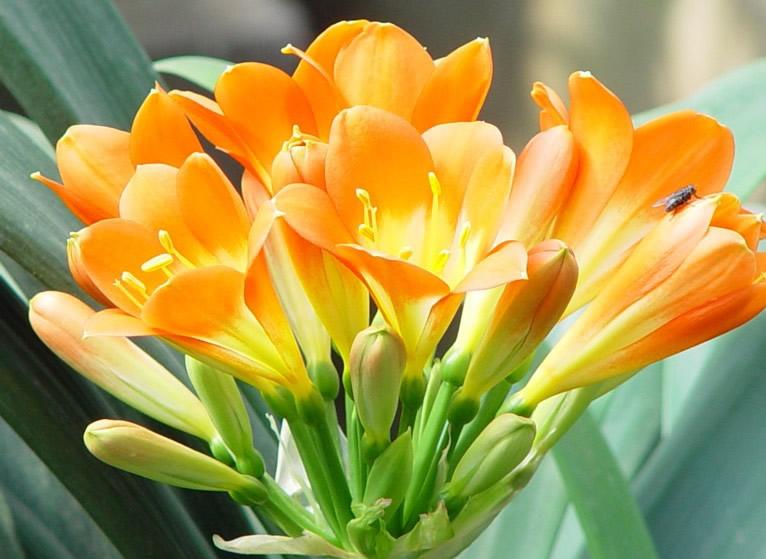
君子兰主要通过种子播种进行繁殖。
#君子兰 的花期是入冬后至次年3-4月份,花后种子成熟也需9-10个月,故君子兰的播种宜在11-12月份。播种前要进行选种,将空瘪发育不良的种子剔除。可用一般花盆播种,下面用粗沙砾或碎石砾铺成2厘米厚的排水层,然后铺一层腐叶土和河沙混合的培养土,厚约4-5厘米,在铺上0.5-1厘米的河沙作播种层。点播时,株距2厘米,然后用沙覆盖。覆土后浸1次水,盖上玻璃盖。播后保持20℃-25℃的气温有利发芽。
从发芽到长出第一片叶需2个月,以后要揭开玻璃盖通风,并逐渐去掉玻璃盖。播后90天便可移栽。移植时,先用竹签或竹筷扎孔,将肉质根插入土中,深度以埋住根茎露出种子为宜,同时注意叶片朝向一致。移后浇1次透水,过数日缓苗后再接受光照。苗期温度控制在15℃-20℃,冬春可见阳光,春、夏季应在散射光下生长,入秋后即可定植栽培。

君子兰分株繁殖,需做好以下工作:
①家庭盆栽宜用泥瓦盆,这种盆透气性好,有利于植株生长。
②准备好已消毒过的介质土。如用腐殖土混合细沙的,腐殖土要用高锰酸钾1000-2000倍水溶液喷洒消毒;细河沙也要用开水烫洗消毒,避免幼苗受病菌感染腐烂。
③准备少量木炭粉涂抹伤口,供吸潮防腐之用。
④分株时,将君子兰从盆中磕出来,拍松盆土,理顺根系,找出可以分株的腋芽:如果子株长在母株的外沿,株体较小,可以一手握住鳞茎部分,另一手捏住子株基部,轻轻一掰,就能将子株掰离母株;如果子株粗壮,则用锋利的刀将其切下。然后用于木炭粉涂抹伤口,以吸干流液,防止腐烂。让子株、母株在室内晾干后再种植,种植深度以埋住子株的基部假鳞茎为度,靠植株的部位要使其略高些,并盖上已消毒的沙土。种好后过2天再浇1次透水,2周后待伤口愈合时,再加盖一层培养土。一般需1-2个月才能生出新根,1-2年后便可开花。
0
0
文章
Colour_
2017年08月08日


一、盆栽#风信子
可用腐叶土、园土和沙土各1/3配制培养土,栽植深度以鳞茎的肩部与土面等平为宜。栽后充分浇水,放人冷室内,室温保持在4 ~6℃,促使其发根。待花茎开始生长时须将花盆移到温暖处。
日常养护:风信子喜光照充足和比较湿润的环境,因此,生长期间要放置在阳光充足的地方,同时要经常保持盆土湿润。抽出花葶后每天向叶面上喷水1~2次,以增加空气湿度。风信子正常花期在3―4月间,开花前后各施1~2次腐熟的稀薄液肥。花后施肥有助促进子球生长。6月气温渐热,叶片枯黄,这时应将鳞茎从盆内磕出,略加干燥,放室内通风阴凉处贮藏。
二、地栽风信子
宜选择土质疏松肥沃、排水良好的地方,于9~10月种植。种植前要耕翻土地,并施人大量腐熟有机肥和少量骨粉。花坛栽植时株距约为15厘米,栽后覆土5―8厘米,充分浇水,并盖草帘保墒。冬季不需要防寒保护。一般每隔3―4年挖掘1次分球后再种。在长江流域繁殖主要用分球繁殖法。夏季,风信子植株枯萎进入休眠期,将其从土中挖出,晾干贮藏,到秋季9―10月栽植前,将子球与母球分离,另行栽植即可。
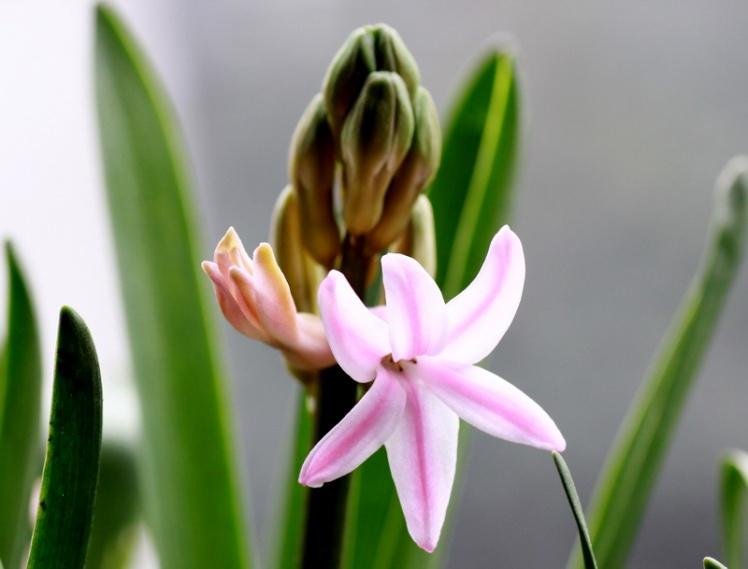
注意事项:
①子球不能在夏季挖出时分离,否则容易腐烂。
②栽培后期要节水节肥,避免鳞茎“裂底”发生腐烂。
③适时采收,早则生长不充实;迟则遇雨季,会使鳞茎不易阴干,影响贮藏。
④除去病球,减少传染。
为促使其母球产生更多的小子球,可于休眠期在母鳞茎底部的鳞茎盘上用小刀划出十字形或米字形伤口,埋入沙中2―3周,待伤口愈合后,再栽人培养土中。夏末,母鳞茎盘四周就会产生许多小鳞茎,待小鳞茎长到1厘米左右时,就可以分开栽培了。

0
0
文章
Dummer. ゛☀
2017年08月07日

Description
This slender but tall orchid grows up to 60cm tall. There are 3-8 narrow, pointed leaves arranged along the stem which is flushed deep purple. The inflorescence is lax and carries between 9-22 large dark pink flowers. The erect lateral sepals are bent backwards and are often so close that they touch each other. A hood is formed by the dorsal sepal and the two upper petals. The flower lip is sharply folded length-wise and has a pale (almost white) centre which is usually unmarked or occasionally lightly marked with pink.
Distribution
The range of this species extends from the Algarve region of Portugal (where it is very rare) as far north as Sweden and east to the westerly parts of Asia. It is not recorded in mainland Britain but is found in the Channel Islands where it is referred to as the Jersey Orchid.
Habitat
This orchid prefers damp alkaline habitats and can be found in fens, marshy meadows and beside streams.
Flowering times
In the far south this orchid flowers in April and May, but further north it can be found in full bloom to the end of June
This slender but tall orchid grows up to 60cm tall. There are 3-8 narrow, pointed leaves arranged along the stem which is flushed deep purple. The inflorescence is lax and carries between 9-22 large dark pink flowers. The erect lateral sepals are bent backwards and are often so close that they touch each other. A hood is formed by the dorsal sepal and the two upper petals. The flower lip is sharply folded length-wise and has a pale (almost white) centre which is usually unmarked or occasionally lightly marked with pink.

Distribution
The range of this species extends from the Algarve region of Portugal (where it is very rare) as far north as Sweden and east to the westerly parts of Asia. It is not recorded in mainland Britain but is found in the Channel Islands where it is referred to as the Jersey Orchid.

Habitat
This orchid prefers damp alkaline habitats and can be found in fens, marshy meadows and beside streams.

Flowering times
In the far south this orchid flowers in April and May, but further north it can be found in full bloom to the end of June
0
0
文章
Dummer. ゛☀
2017年08月07日

For people living in Britain and Ireland, Candytuft in the form of a cultivar is associated with neat, edged flowerbeds in gardens and parks in the height of summer.
Identification
The flowers of Burnt Candytuft, a dwarf rock plant, are 3 to 6 mm across and have four notched petals; they are variable in colour and can be white, pink or mauve. Stems range from 3 to 35 cm tall and have a rather woody base.
Distribution
Burnt Candytuft is found in the western and central Mediterranean from Spain eastwards to Greece and also in Sardinia, Sicily and Crete.
Habitat
This member of the brassicaceae (Cabbage family, formerly known as cruciferae) grows in rocky habitats in the hills and mountains.
Blooming Times
Burnt Candytuft blooms in springtime.
Identification
The flowers of Burnt Candytuft, a dwarf rock plant, are 3 to 6 mm across and have four notched petals; they are variable in colour and can be white, pink or mauve. Stems range from 3 to 35 cm tall and have a rather woody base.

Distribution
Burnt Candytuft is found in the western and central Mediterranean from Spain eastwards to Greece and also in Sardinia, Sicily and Crete.
Habitat
This member of the brassicaceae (Cabbage family, formerly known as cruciferae) grows in rocky habitats in the hills and mountains.

Blooming Times
Burnt Candytuft blooms in springtime.
0
0
文章
Miss Chen
2017年08月06日


Description: This shrubby perennial is up to 3¼' tall. It tillers at the base, sending up multiple stems that are erect to ascending. These stems are light green to light yellow, terete, and pubescent or hairy, becoming woody with age in the absence of fire or browsing from animals. The leaves are alternate or opposite; they occur along the entire length of each stem. The leaves are up to 3" long and 2" across; they are ovate in shape and their margins are smooth to finely serrated and slightly ciliate. The upper leaf surface is pale-medium to dark green, and smooth to somewhat rough from minute stiff hairs. The lower leaf surface is pale green and pubescent or hairy; hairs are typically more abundant along the lower sides of the veins. The central vein and two primary lateral veins are palmate, while the remaining veins are pinnate; the upper leaf surface is often wrinkled along these veins. The petioles are short, light green to light yellow, and pubescent or hairy. The upper stems terminate in panicles of flowers; axillary panicles of flowers also develop from the axils of upper leaves. The peduncles (basal stalks) of these panicles are 2-8" long, light green to light yellow, terete, relatively stout, and pubescent or hairy.
Individual panicles are 2-5" long and 2-3" across; their lateral branches are up to 1½" long and widely spreading to ascending. Both the rachis and lateral branches are light green, terete, relatively stout, and finely hairy. Along the rachis and lateral branches of each panicle are clusters of flowers on slender white pedicels. These pedicels are ¾–1" long. Each flower is up to ¼" across, consisting of 5 white sepals, 5 white petals, 5 stamens, and a pistil. The sepals are triangular-ovate and folded inward, while the petals are widely spreading. The petals have long narrow bases and widened tips; the lateral edges of these tips are folded upward. The blooming period occurs during early to mid-summer, lasting about 3-4 weeks. There is a pleasant floral fragrance. Afterwards, the flowers are replaced by 3-lobed seed capsules up to ¼" across. At maturity, these capsules become dark brown or black, and they split open to mechanically eject their seeds up to several feet. Each capsule contains 3 seeds that are 2-3 mm. in length, brown to dark brown, glossy, and ovoid in shape. The root system consists of a stout taproot.
Cultivation: The preference is full or partial sun and average to slightly dry conditions. The soil can contain loam, rocky material, or sand. This plant adds some nitrogen to the soil. Germination from seed can be slow and difficult – exposing them to hot water may be helpful. Transplants are easier to manage and faster to develop. Drought resistance is very good – under severe conditions, the leaves will become discolored and shrivel, but quickly revive when rainfall returns. Foliar disease is rarely a significant problem.
Range & Habitat: The native New Jersey Tea occurs throughout Illinois, except for a few counties in the southern part of the state (see Distribution Map). It is occasional to locally common in high quality habitats, but uncommon elsewhere. Habitats include mesic to dry black soil prairies, gravel prairies, sand prairies, hill prairies, sandy savannas, rocky upland forests, limestone glades, and barrens with scrubby vegetation. Occasional fire is a beneficial management tool in promoting the development and spread of this plant.
Faunal Associations: The nectar and pollen of the flowers attract a variety of insects, especially bees, wasps, flies, and beetles. These floral visitors include Halictid bees (Agapostemon spp., Halictus spp., Lasioglossum spp.), Andrenid bees (Andrena spp.), plasterer bees (Colletes spp.), Sphecid wasps (Oxybelus spp., Cerceris spp., Tachysphex spp.), Vespid wasps (Polistes spp., Stenodynerus spp.), spider wasps (Anoplius spp.), Syrphid flies, thick-headed flies (Conopidae), Tachinid flies, flesh flies (Sarcophagidae), bottle flies (Lucilia spp.), Muscid flies, and miscellaneous beetles (Robertson, 1929). Hairstreak butterflies (Satyrium spp.) also visit the flowers. Other insects feed destructively on the foliage, seeds, and other parts of New Jersey Tea. These species include stem-boring larvae of a long-horned beetle (Calliomoxys sanguinicollis), leaf beetles (Babia quadriguttata, Pachybrachis trinotatus), seed-eating broad-headed bugs (Alydus spp.), and the Angulate Tingid (Gargaphia angulata); see Yanega (1996), Clark et al. (2004), Schaeffer (1980), and Cranshaw (2004). In addition, the larvae of several moths feed on New Jersey Tea, including the Broad-lined Erastria (Erastria coloraria), Sulfur Moth (Hesperymia sulphuraria), and Red-fronted Emerald (Nemoria rubrifrontaria); the caterpillars of a butterfly, the Spring/Summer Azure (Celastrina argiolus), and caterpillars of a skipper, the Mottled Duskywing (Erynnis martialis), also feed on this shrub (Covell, 1984/2005; Bouseman & Sternburg, 2001; and Bouseman et al., 2006).
The foliage and stems are readily consumed by various mammalian herbivores, including elk (native in Illinois at one time), deer, rabbits, and livestock (Martin et al., 1951/1961). Some upland gamebirds, like the Wild Turkey and Bobwhite Quail, also use New Jersey Tea as a food source (Van Dersal, 1939). This can make the establishment of this plant difficult where there is an overpopulation of such animals.
Photographic Location: The photographs were taken at Loda Cemetery Prairie in Iroquois County, Illinois.
Comments: This little shrub has a lot going for it from both horticultural and ecological perspectives. It was used by colonists during the Revolutionary War as a substitute for tea (hence the common name), even though the leaves contain no caffeine. Early pioneers discovered that the stout roots of New Jersey Tea (Ceanothus americanus) were a formidable barrier to the plow. Chemical compounds from this plant have been found to affect the speed of blood coagulation (Lynch et al., 1958), and they have been found to have antimicrobial properties on oral pathogens (Li et al., 1997). The only other species in this genus that occurs in Illinois, Redroot (Ceanothus ovatus), differs from New Jersey Tea by having more narrowly shaped leaves and shorter panicles of flowers.

0
0
文章
Miss Chen
2017年08月06日


Description: This perennial wildflower consists of a low rosette of basal leaves up to 1½' across and a flowering stalk about 1½–2' tall. The floppy basal leaves are 6-12" long and 1/3" (8 mm.) across; they are medium to dark green, linear in shape, parallel-veined, glabrous, and smooth along their margins. Along the underside of each basal leaf, there is a prominent mid-rib. The erect central stalk is slender, light to medium green, and glabrous; it terminates in a spike-like raceme of flowers that is several inches in length. Underneath the floral spike, there are usually 1-3 bracts along the stalk. These bracts are green, linear to linear-lanceolate in shape, and up to ¾" long. Each flower is ¾–1" across, consisting of 6 tepals, 6 stamens with bright yellow anthers, and a green central ovary with a slender style. The tepals are light blue-violet to nearly white; they are oblong in shape and spread widely from the center of the flower. Each tepal (petal or petal-like sepal) has 1-3 poorly defined veins along its length.
At the base of each flower, there is a single linear bract up to ¾" long that is early-deciduous. The slender pedicel of each flower is about the same length as the bract. The flowers begin to bloom from the bottom of the raceme and continue to bloom upward toward the apex; each flower lasts only 2-3 days. The blooming period occurs from mid- to late spring and lasts about 2-3 weeks. Each fertilized flower is replaced by a 3-celled seed capsule that is about 1/3" in length and nearly as much across. Each seed capsule contains many small seeds that are black and shiny. The basal leaves turn yellow and wither away by mid-summer. The root system consists of a bulb with fibrous roots. This wildflower reproduces by reseeding itself.
Cultivation: The preference is full sun to light shade, moist conditions, and rich loamy soil. Wild Hyacinth is slow to develop, but fairly long-lived. Vegetative growth and development occurs during the cool weather of spring, when adequate moisture is essential.
Range & Habitat: Wild Hyacinth is found occasionally throughout Illinois (see Distribution Map), where it is native. Habitats include moist black soil prairies, moist savannas, moist open woodlands (particularly along the banks of streams), rocky wooded slopes, and limestone glades. This species is typically found in high quality habitats, whether prairies or woodlands.
Faunal Associations: The flowers attract their fair share of insects, including many bees and flies, and occasional butterflies and wasps. Most of these insects seek nectar from the flowers, although some short-tongued bees also collect pollen. Bee visitors include honeybees, bumblebees, Cuckoo bees (Nomada spp.), and Halictid bees (Halictus spp., Lasioglossum spp., etc.). Other floral-faunal relationships are poorly understood. White-Tailed Deer occasionally chomp off the tops of the basal leaves. Both the foliage and bulbs are not known to be toxic to mammalian herbivores.
Photographic Location: Along a woodland stream in Douglas or Coles County in east-central Illinois.
Comments: Wild Hyacinth has attractive flowers that are conspicuous during the spring. It is usually found in woodland habitats, but also occurs in prairies. Wild Hyacinth differs from the less common Camassia angusta (Prairie Hyacinth) in several ways, among them: 1) It has slightly larger flowers than the latter, 2) its flowers are usually a slightly lighter shade of blue-violet, 3) its seed capsules are about as broad as long, while Prairie Hyacinth has seed capsules that are slightly longer than broad, 4) the bracts of its flowering stalk are less persistent than those of Prairie Hyacinth, and 5) it blooms earlier in the spring.

0
0
文章
Miss Chen
2017年08月06日


Description: This perennial plant is 1-3½' tall and unbranched, except near the apex where the flowering stems occur. The stems are round and covered with fine white hairs. They are initially green, but often become brown with age. The alternate leaves are up to 4" long and 1½" across. They are sessile against the stem toward the top, but have short petioles near the bottom. These leaves are lanceolate, smooth or sparingly dentate, grey- or yellow-green, and finely pubescent. The smaller leaves near the flowerheads are much reduced in size and linear. Sometimes there are small leaves appearing in the upper axils of the larger leaves along the central stem.
The upper stems terminate in small corymbs of flowerheads. These flowerheads consist of 7-21 small creamy white florets. A floret is narrowly tubular with 5 small lobes and a protruding divided style. Each flowerhead is subtended by a cylinder of narrow green bracts; it is a little less than ½" long. The blooming period occurs during late summer or early fall, and lasts about a month. The achenes are long and cylindrical, grey or light brown, and have tufts of white hair (or sometimes tawny hair). These tufts of hair are often more striking in appearance than the flowers. Seed distribution is provided by the wind. The root system consists of a central taproot that can run deep into the ground. Sometimes, this plant will tiller at the base, sending up multiple stems from the taproot. However, it doesn't reproduce vegetatively by means of rhizomes, unlike many other prairie plants.
Cultivation: The preference is full sun and dry conditions; a little shade is also tolerated. This plant prefers poor soil that contains too much clay, sand, or gravel, and it can thrive on slopes. Its toleration of drought is better than most plants in the tallgrass prairie. The leaves may turn yellow and start to shrivel away toward the end of the year, but this is normal. This plant doesn't spread aggressively.
Range & Habitat: The native False Boneset occurs occasionally in central and northern Illinois; in many areas of southern Illinois, it is uncommon or absent (see Distribution Map). Habitat includes dry upland areas of black soil prairies, gravel prairies, dolomite prairies, clay prairies, hill prairies, bluffs, limestone glades, open woodlands, and sandy savannas. False Boneset doesn't form large colonies, but is more likely to occur as sporadic plants. In moist areas with rich soil, it has trouble competing with taller, more aggressive forbs and grasses.
Faunal Associations: Bumblebees, leaf-cutting bees (Megachile spp.), Halictid bees, and other bees visit the flowerheads for nectar and pollen (Mitchell, 1960/1962; Moure & Hurd, 1987). Butterflies, skippers, and probably other insects visit the flowerheads for nectar and/or pollen too. The caterpillars of some flower moths feed destructively on the flowerheads and developing seeds; they include such species as Schinia trifascia (Three-lined Flower Moth), Schinia oleagina (Oleagina Flower Moth), and Schinia grandimedia (False Boneset Flower Moth). The last moth occurs in areas that lie mostly west of Illinois. Other insects feeders include Lygus lineolaris (Tarnished Plant Bug) and other polyphagous stink bugs, Aphis coreopsidis (an aphid), and larvae of a Noctuid moth, Dichagyris grotei (Panzer, 2000; Vestal, 1913; Hottes & Frison, 1931). In addition, such grasshoppers as Melanoplus confusus (Little Pasture Grasshopper), Melanoplus differentialis (Differential Grasshopper), Melanoplus keeleri (Keeler's Grasshopper), and Melanoplus discolor (Contrasting Spur-throated Grasshopper) feed on False Boneset. The last grasshopper is monophagous on this plant, although it occurs in areas that lie west of Illinois (Campbell et al., 1974; Joern, 1985; Brust et al., 2008). Mammalian herbivores browse on False Boneset occasionally when little else is available, but its foliage is bitter and overall food value is low. In pastures, False Boneset is considered an 'increaser' because livestock are not particularly fond of it.
Photographic Location: The photographs were taken at Meadowbrook Park in Urbana, Illinois.
Comments: False Boneset is similar in appearance to Tall Boneset (Eupatorium altissimum). However, the former plant has alternate leaves along its stems with only one conspicuous vein, while the latter has opposite leaves with three conspicuous veins. An older scientific name for False Boneset is Kuhnia eupatorioides.

0
0
文章
Miss Chen
2017年08月06日


Description: This wildflower consists of a low rosette of basal leaves up to 6" across; a mature plant will produce one or more flowering stalks about ½–1' tall. The blades of the basal leaves are up to 3" long and 2½" across; they have stout hairy petioles up to 1½" long. The basal leaves are more or less oval in shape, crenate along their margins, palmately veined, and hairy on both their upper and lower surfaces; the upper surface of each leaf is medium green, while the lower surface is pale green or pale purplish green. Each flowering stalk is stout, erect, terete, light green, and very hairy; it has small alternate leaves up to 1¼" long and ½" across, which become gradually smaller as they ascend toward the inflorescence. The alternate leaves are similar to the basal leaves, except they are ovate in shape and smaller in size. Each alternate leaf is sessile or it clasps the stalk.
The inflorescence consists of a stout spike of small flowers about 2-6" long. These flowers are densely clustered along the spike, facing in all directions. Underneath each flower, there is a small leafy bract that is lanceolate. Each flower has a 2-lipped corolla that is cream-colored or pale yellow, and a calyx consisting of 4 green sepals that are elliptic and hairy. The corolla is about 5 mm. long and slightly longer than the calyx; the upper lip of the corolla is unlobed, while the irregular lower lip is unlobed or divided into 2-3 lobes. Each flower has a pair of exserted stamens and a slender white style. The blooming period occurs from mid-spring to early summer, lasting about 3 weeks for a colony of plants. The flowers bloom gradually from the bottom of the spike to its apex. Afterwards, the flowers are replaced by small 2-celled seed capsules; each capsule contains several seeds. The root system consists of a cluster of coarse fibrous roots; an older plant may form a small caudex. This wildflower occasionally forms colonies at favorable sites.
Cultivation: The preference is full sun, dry conditions, and a barren acidic soil that is sandy or gravelly. Partial sun is also acceptable. This wildflower grows slowly and doesn't tolerate competition from taller, more aggressive plants. It is adaptable to sunny rock gardens and there are few problems with pests and disease.
Range & Habitat: The native Kittentails is restricted to the west-central and northwest sections of Illinois, where it is rare (see Distribution Map). This wildflower is state-listed as 'threatened.' Habitats include dry sand prairies, dry gravel prairies, hill prairies, barren savannas, thinly wooded bluffs, and sandy or gravelly riverbanks. This species is restricted to high quality habitats in natural areas; it is endemic to the Midwest and uncommon throughout its range.
Faunal Associations: The flowers are cross-pollinated by small bees, especially Halictid bees that seek nectar and/or pollen. The following Halictid bees have been observed to visit the flowers of Kittentails: Auglochlorella striata, Lasioglossum anomalum, and Lasioglossum vierecki (McKone et al., 1995; Moure & Hurd, 1987). Additional information about floral-faunal relationships is unavailable.
Photographic Location: The wildflower garden of the webmaster in Urbana, Illinois.
Comments: While not particularly showy, Kittentails is an unusual little plant. It resembles some broad-leaved Plantago spp. (Plantains), but the floral spike of Kittentails is more stout and its flowers are insect-pollinated. The closest relatives (either Besseya spp. or Synthyris spp.) are found in mountainous areas of the western states. These latter species usually have flowers (or floral bracts) that are purple, otherwise they are similar in appearance to their eastern counterpart. Another scientific name of Kittentails is Wulfenia bullii.

0
0





